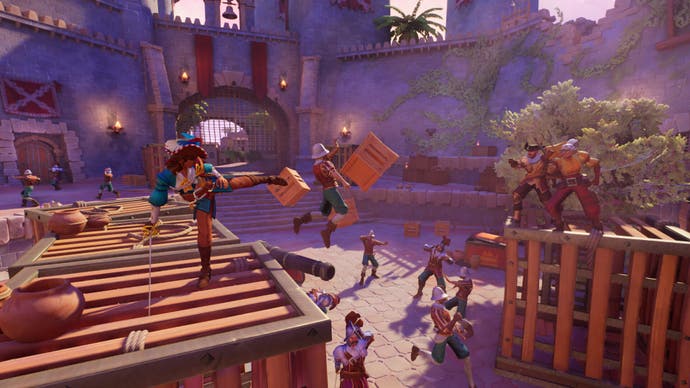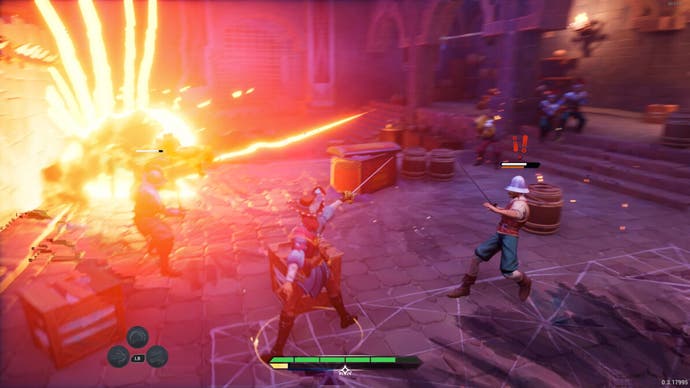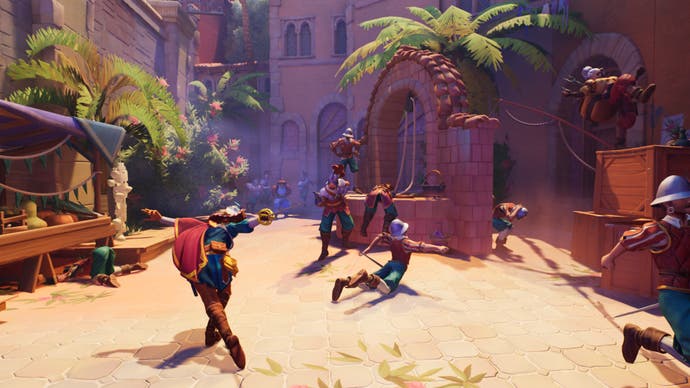How En Garde!'s fencing earned its cinematic flourishes
"A couple of us took up stage fencing during development."
During my twenties, I decided that I would start fencing.
I wasn't very strong, but I did have some quickness and agility, and I liked how fencers seemed to epitomise those last two qualities. I wasn't very good at the sport, ultimately, because fencing doesn't just require speed and agility, but also timing, distance measurement, and skill. (I also foolishly approached it as something more instinctive than cerebral.) Fencing movements, at least from my experience with a 'foil' (one of the weapons), are very small and subtle, and the best approach is sometimes a very simple manoeuvre. Someone attacks? You parry the strike by pushing it to the side just to the point where it misses, and then stick your own foil out in a riposte to their upper body. You may not even have to move your legs during such a sequence.
I didn't actually want to fence like this, though. I wanted to use dramatic and flashy movements, the kind you might see in a pleasing cinematic duel.
Rather than parry attacks, for example, I was very fond of dropping my foil completely and leaning straight back, something that a fellow novice joked was akin to Neo's famous dodging in The Matrix; a very ill-advised thing to do in fencing, but still wonderfully enjoyable when you could make the opponent fall just short in their lunge to tag you. I'd then take one step back with my right foot to regain my balance and quickly snap it back again in front of my left, as if dancing. I liked to weave my upper body around too, like a boxer, in a way that may have looked sillier than It felt.
In one match I attempted to wait until my opponent lunged, and then (my feet still planted) I bent my upper torso all the way to the right -- as if reflexively dodging a ball thrown at me -- and simultaneously hit him with a counter. I landed, but the opponent's foil tip glanced against my vest just enough to trigger the scoring system, and he took the point. (In foil fencing the one who attacks first wins the point even if you catch them coming in.) He stopped and looked at me, a bit taken aback, and just offered an appreciative noise. After a different match with another opponent (where I indulged in my usual odd moves) they smiled and said that I was 'fun to fight'.
I was only able to move in quite a narrow way in fencing; straight forward and straight back, with no significant lateral movement. My body ached with the need to do more. I remember leaving the fencing hall briefly on one occasion to find some equipment, and I happened to stop near another closed room. I could hear music playing inside, and when I looked in I saw people practising the fluid Afro-Brazilian martial art of Capoeira (video game fans will recognise the style, perhaps, as the one Eddy Gordo uses in the Tekken series). The Capoeira practitioners looked exactly like how I wanted to feel: relaxed, comfortable, and free.
En Garde!, by Fireplace Games, allows me to fence the way I always wanted to in reality. The moment I realised that I could bend to the side to dodge attacks, in a similar way to what I had done against my real opponent years earlier, I was delighted. There is more, though. Adalia de Volador, the protagonist, can jump and roll away from sword swipes, sidestep to the left with a little ducking twist, and even use a spinning back kick to send enemies stumbling. She can thrust as you would do in foil fencing, but also slashes as you would with the sabre. Her parry is always a flashy circular one where the blade sparkles under the light, and she swings from wooden beams as elegantly as Zorro himself. I wanted to know more.

The game actually first emerged as a student graduation project in 2018, and has now been built into a significantly expanded and improved work. Two of the developers that I approached after playing the demo, Julien Fenoglio and Adrien Poncet, inform me over a joint email that they drew inspiration from "the cape et d'épée (literally 'cloak and sword') genre", which "was popularised in the 19th century and revolves around the exploits of heroic swordsmen, rife with political intrigue and romance with a good dose of suspense and twists."
"The works of Dumas such as The Three Musketeers and The Count of Monte Cristo exist as a sort of 'background radiation' within our mindscapes," they add.
They didn't just draw from French influences. There is also the impact of American cinema: 'The Princess Bride' and Zorro, along with Errol Flynn's work. The game itself is set in Spain, which was decided as a homage to "the comedia de capa y espada tradition from the Spanish Golden Age in the 17th century", a dramatic subgenre usually featuring "duels, jealousies, and romantic intrigues".

Despite the emphasis on theatre, film, and literature, they also looked at some examples of real fencing and depicted it in the game, referencing movements from Spanish ("Destreza") and Italian ("Bolognese") swordsmanship for Adalia's enemies. After reading a little about Destreza for myself and seeing some illustrations, I can also see some possible influence of this in Adalia's basic stance, where she elegantly holds out her blade as if preparing to catch the opponent coming in.
"A couple of us also took up stage fencing during development," the developers tell me, "and it gave us insights into body mechanics and choreography (and was loads of fun). Our animators also previously practised martial arts or worked on games featuring them (e.g.: Sifu), which of course was a great perk too."
One of the main 'pillars' of their approach to making the game when it was a student project was an emphasis on 'panache', and this seems to still hold true.
"Panache is at the heart of being a swashbuckling hero" the developers tell me. "It's about laughing in the face of danger, acting with daring and with style. We want players to feel this kind of effortless prowess, but also to adapt their plans and improvise to each perilous situation."

They want the game to leave players feeling uplifted, for them to laugh and smile. "If we really wanted to wax lyrical about it," they add, "I'd want players to take away the game's attitude: idealism, a light heart, a healthy disregard for authority, the smiling resilience to back up one's daring."
"Perhaps," they wonder, "it'll inspire more explorations of swashbuckling in games and other media."
There is some of the lightness and confidence of Adalia and the game itself in their responses, some of the 'zest' that Ray Bradbury believed so important. The final remark from the developers is thus fittingly playful; they reveal that they are crossing their fingers for fan art and fan fiction.
Despite the research into real swordsmanship, En Garde! isn't really trying to pursue realism. It's pursuing the stylish kind of fun I always prized when I was fencing years ago. I'm reminded of Matt Nava talking about his goals for the memorable Abzu, and how he didn't want to make a "scuba simulator"; he wanted to make something that conveyed the dream of scuba diving. En Garde! wants to take you into a theatrical, swashbuckling adventure, where you can fight with panache and whimsy: the dream of being a musketeer.









.jpg?width=291&height=164&fit=crop&quality=80&format=jpg&auto=webp)
_Rwmp6uD.jpg?width=291&height=164&fit=crop&quality=80&format=jpg&auto=webp)